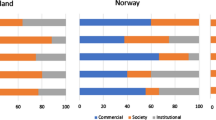Abstract
Two types of series of h-indices for journals published in the field of Horticulture during the period 1998–2007 are calculated. Type I h-indices are based on yearly data, while type II h-indices use cumulative data. These h-indices are also considered in a form normalised with respect to the number of published articles.
It is observed that type I h-indices, normalised or not, decrease linearly over a period of ten years. The type II series, however, is not linear in nature: it exhibits partly a concave shape. This proves that the journals (in Horticulture) do not exhibit a linear increase in h-index as argued by Hirsch in the case of life-time achievements of scientists.
In the second part of the paper, an attempt is made to study the relative visibility of a journal and its change over time, based on h-indices of journals. It is shown that:
-
the h-index over the complete period 1998–2007 of the journal Theoretical & Applied Genetics (h = 62) is much higher than that of all other journals in the field
-
the relation between the number of publications and the type II h-index for the whole period is not an exact power law (as it would have to be if the Egghe-Rousseau model were applicable)
-
in order to study the dynamic aspects of journal visibility, a field-relative normalised h-ratio is defined to monitor systematic changes in the field of Horticulture. Except for two journals, the Pearson correlation coefficient for yearly values of this field-relative normalised h-ratio indicates that there is no systematic change of the performance of the journals with respect to the field as a whole.
Similar content being viewed by others
References
Banks, M. G. (2006), An extension of the Hirsch index: indexing scientific topics and compounds. Scientometrics, 69: 161–168.
Braun, T., Glänzel, W., Schubert, A. (2006), A Hirsch-type index for journals. Scientometrics, 69: 169–173.
Burrell, Q. L. (2007a). Hirsch’s h-index: a stochastic model. Journal of Informetrics, 1: 16–25.
Burrell, Q. L. (2007b). Hirsch’s h-index and Egghe’s g-index. In: D. Torres-Salinas, H. F. Moed (Eds), Proceedings of ISSI 2007, Madrid, CSIC, pp. 162–169.
Burrell, Q. L. (2007c). Hirsch index or Hirsch rate? Some thoughts arising from Liang’s data. Scientometrics, 73: 19–28.
Egghe, L. (2007), Dynamic h-index: the Hirsch index in function of time. Journal of the American Society for Information Science and Technology, 58: 452–454.
Egghe, L., Rousseau, R. (1990). Introduction to Informetrics. Amsterdam: Elsevier.
Egghe, L., Rousseau, R. (2006). An informetric model for the h-index. Scientometrics, 69: 121–129.
Hirsch, J. E. (2005), An index to quantify an individual’s scientific research output. Proceedings of the National Academy of Sciences of the United States of America, 102: 16569–16572.
Jin, B. H., Liang, L. M., Rousseau, R., Egghe, L. (2007), The R- and AR-indices: complementing the hindex. Chinese Science Bulletin, 52: 855–863.
Kelly, C. D., Jennions M. D. (2006), The h index and career assessment by numbers. Trends in Ecology and Evolution, 21167–21170.
Liang, L. M. (2006), H-index sequence and h-index matrix: constructions and applications. Scientometrics, 69: 153–159.
Liu, Y. X., Rousseau, R. (2007), Hirsch-type indices and library management: the case of Tongji University Library. In: D. Torres-Salinas, H. F. Moed (Eds) Proceedings of ISSI 2007, Madrid, CSIC, pp. 514–522.
Liu, Y. X., Rousseau, R. (2008), Definitions of time series in citation analysis with special attention to the h-index. Journal of Informetrics, 2: 202–210.
Rao, I. K. R. (2007), Distributions of Hirsch-index and g-index: an empirical study, In: D. Torres-Salinas, H. F. Moed (Eds) Proceedings of ISSI 2007, Madrid, CSIC, pp. 655–658.
Rousseau, R. (2006), A case study: evolution of JASIS’ h-index. Science Focus, 1(1): 16–17 (in Chinese). English version available at: E-LIS: ID-code 5430.
The Stimulate-6 Group (2007), The Hirsch index applied to topics of interest to developing countries. First Monday, 12(2). http://www.firstmonday.org/issues/issue12_2/stimulate
Author information
Authors and Affiliations
Corresponding author
Rights and permissions
About this article
Cite this article
Liu, Y., Ravichandra Rao, I.K. & Rousseau, R. Empirical series of journal h-indices: The JCR category Horticulture as a case study. Scientometrics 80, 59–74 (2009). https://doi.org/10.1007/s11192-007-2026-z
Received:
Published:
Issue Date:
DOI: https://doi.org/10.1007/s11192-007-2026-z




